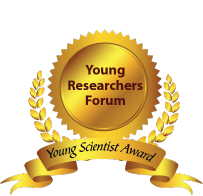Call for Abstract
Scientific Program
21st European Organic Chemistry Congress, will be organized around the theme “Next-Generation Organic Chemistry: Bridging Science & Industry”
Euro Organic Chemistry 2025 is comprised of keynote and speakers sessions on latest cutting edge research designed to offer comprehensive global discussions that address current issues in Euro Organic Chemistry 2025
Submit your abstract to any of the mentioned tracks.
Register now for the conference by choosing an appropriate package suitable to you.
Organic synthesis focuses on constructing complex molecules used in pharmaceuticals, materials, and agrochemicals. Advances include novel catalysts, regioselective reactions, and streamlined methodologies that improve reaction efficiency, sustainability, and scalability. These innovations lead to more cost-effective and environmentally friendly synthesis, reducing waste and energy consumption while expanding the possibilities of molecular design for industrial and research applications.
Green chemistry aims to design chemical processes that reduce environmental impact by using renewable resources, minimizing hazardous waste, and improving energy efficiency. This track explores eco-friendly solvents, bio-based feedstock, and sustainable catalytic systems. Innovations in this field help industries transition toward cleaner production methods, promoting safer alternatives in pharmaceuticals, polymers, and industrial chemicals while addressing global sustainability challenges.
Catalysis accelerates chemical reactions, increasing efficiency while reducing energy consumption and waste. This track covers organocatalysis, metal catalysis, and enzymatic catalysis, which are essential for selective transformations in pharmaceuticals, fine chemicals, and sustainable materials. Catalysts enable more precise chemical reactions, enhancing product yields and purity while minimizing the use of harmful reagents and extreme reaction conditions.
Computational chemistry and artificial intelligence (AI) are revolutionizing molecular design, reaction prediction, and drug discovery. This track explores molecular modelling, quantum chemistry, and AI-driven approaches that optimize chemical synthesis, reduce experimental costs, and accelerate innovation. By simulating reactions and predicting compound behaviours, these technologies enhance efficiency and precision in research and industrial applications.
Natural products, derived from plants, microbes, and marine organisms, serve as a foundation for drug discovery. Medicinal chemistry focuses on modifying these compounds to develop effective pharmaceuticals. This track highlights isolation techniques, structural modification, and synthetic strategies to optimize bioactivity, enhance drug efficacy, and overcome challenges such as resistance and bioavailability.
Polymer chemistry studies the design, synthesis, and application of macromolecules, including plastics, biopolymers, and advanced materials. This track explores the development of high-performance, biodegradable, and functional polymers for industries like medicine, electronics, and aerospace. Advancements in this field contribute to sustainable packaging, smart materials, and bio-compatible polymers used in medical devices.
Supramolecular chemistry focuses on intermolecular interactions, while Nano chemistry studies molecular structures at the nanoscale. These disciplines enable self-assembled materials, molecular recognition, and nanostructured catalysts, impacting fields like drug delivery, sensors, and organic electronics. Understanding these interactions leads to innovations in medicine, energy storage, and material science.
Photochemistry explores light-driven chemical reactions, while electrochemistry focuses on electron-transfer processes. These fields enable sustainable synthesis, energy storage, and organic electronic applications. This track covers photocatalysis, electrosynthesis, and their role in green chemistry, including solar energy conversion, battery technology, and organic semiconductor development.
Organometallic chemistry studies compounds containing metal-carbon bonds, playing a key role in catalysis, material science, and industrial applications. This track explores transition metal catalysts, metal-organic frameworks (MOFs), and their impact on pharmaceuticals, polymers, and sustainable chemistry, enabling more selective and efficient transformations.
Peptide and protein chemistry focuses on the synthesis, modification, and structure-function relationships of biomolecules. This track covers peptide therapeutics, protein engineering, and bio-conjugation techniques, essential for developing novel drugs, biomaterials, and molecular probes used in diagnostics and targeted therapies.
Heterocyclic compounds, which contain rings with non-carbon atoms (such as nitrogen or oxygen), are fundamental in pharmaceuticals, agrochemicals, and dyes. Aromatic chemistry studies benzene-like structures with unique stability. This track explores their synthesis, functionalization, and applications in drug discovery, organic electronics, and specialty chemicals.
Many biological molecules are chiral, meaning they exist in left- and right-handed forms. Asymmetric synthesis creates enantiomerically pure compounds, crucial in pharmaceuticals where different enantiomers can have drastically different biological effects. This track explores chiral catalysts, enantioselective reactions, and their applications in medicine and materials science.
Chemical biology applies chemical techniques to understand biological processes at the molecular level. Bioconjugation involves linking biomolecules like proteins, nucleic acids, or drugs to improve targeted delivery and diagnostics. This track explores biorthogonal reactions, chemical probes, and drug-conjugate therapies in medicine and biotechnology.
Analytical chemistry is essential for characterizing organic compounds. This track covers spectroscopic methods like NMR, mass spectrometry, and IR spectroscopy, which determine molecular structures, reaction mechanisms, and compound purity. These techniques are crucial in pharmaceuticals, forensics, environmental monitoring, and materials science.
Fluorine, chlorine, bromine, and iodine are widely used in pharmaceuticals, agrochemicals, and materials due to their unique chemical properties. This track explores the synthesis of halogenated compounds, their role in drug stability and bioactivity, and their industrial applications.
Carbohydrates play critical roles in biological systems, from cell signalling to immune responses. Glycochemistry focuses on carbohydrate synthesis, glycosylation techniques, and their applications in vaccines, therapeutics, and diagnostics, including cancer and infectious disease research.
Biomimetic chemistry takes inspiration from nature to develop efficient catalysts, self-assembling materials, and sustainable synthetic processes. This track explores enzyme-mimicking catalysts, biohybrid materials, and green chemistry approaches that replicate biological precision in chemical reactions.
Industrial chemistry focuses on scaling up organic reactions for commercial production. This track examines process optimization, flow chemistry, and sustainable manufacturing techniques to enhance efficiency, safety, and cost-effectiveness in chemical industries, including pharmaceuticals and petrochemicals.
Organic electro synthesis and photocatalysis use electricity or light to drive chemical transformations, offering green and energy-efficient alternatives to traditional methods. This track explores their applications in pharmaceuticals, renewable energy, and sustainable chemical production.
This track highlights recent breakthroughs shaping the future of organic chemistry, including AI-driven synthesis, bio hybrid materials, advanced catalysis, and interdisciplinary innovations across medicine, materials science, and sustainability.

